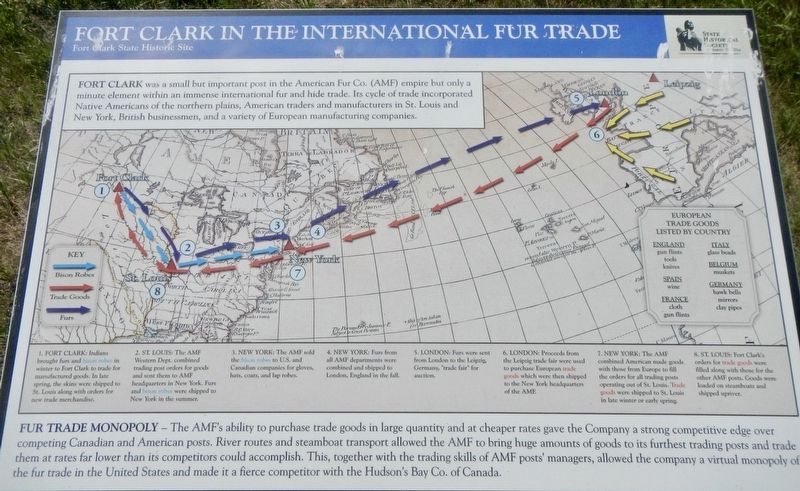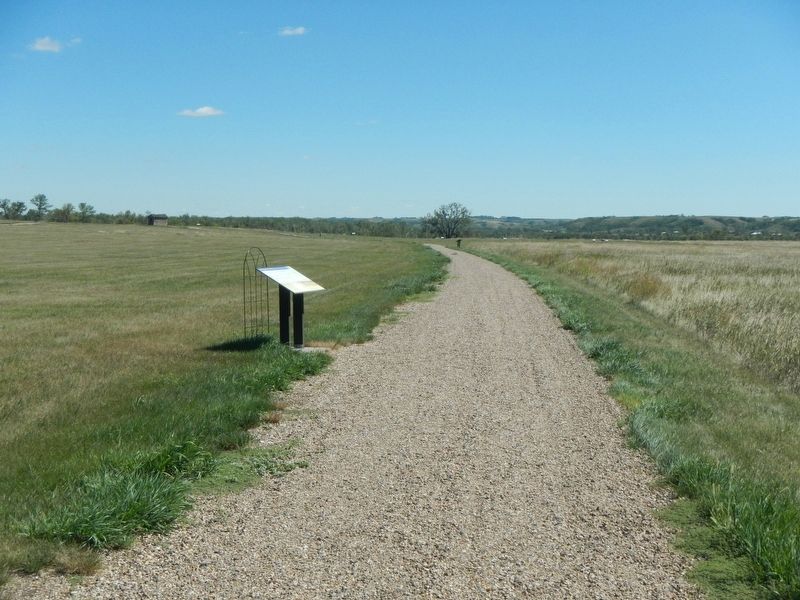Near Stanton in Mercer County, North Dakota — The American Midwest (Upper Plains)
Fort Clark in the International Fur Trade
Fort Clark State Historic Site

Photographed By Barry Swackhamer, August 28, 2020
1. Fort Clark in the International Fur Trade Marker
Captions: (located along the bottom of the map) 1. FORT CLARK: Indians brought furs and bison robes in winter to Fort Clark to trade for manufactured goods. In late spring, the skins were shipped to St. Louis along with orders for new trade merchandise.; 2. ST. LOUIS: The AMF Western Dept. combined trading post orders for goods and sent them to AMF headquarters in New York. Furs and bison robes were shipped to New York in the summer.; 3. NEW YORK: The AMF sold the bison robes to U.S. and Canadian companies for gloves, hats, coats, and lap robes.; 4. NEW YORK: Furs from all AMF departments were combined and shipped to London, England in the fall.; 5. LONDON: Furs were sent from London to the Leipzig, Germany "trade fair" for auction.; 6. LONGON: Proceeds from the Leipzig trade fair were used to purchase European trade goods which were them shipped to the New York headquarters of the AMF. 7. NEW YORK: The AMF combined American made goods with those from Europe to fill the orders for all trading posts operating out of St. Louis. Trade goods were shipped to St. Louis in late winter or early spring.; 8. ST. LOUIS: Fort Clark's order for trade goods were filled along with those for the other AMF posts. Goods were loaded on steamboats and shipped upriver.; (lower right corner of map) EUROPEAN TRADE GOODS LISTED BY COUNTRY: England: gun flints, tools, knives; Spain: wine; France: cloth, gun flints; Italy: glass beads; Belgium: muskets; Germany: hawk bells, mirrors, clay pipes.
The AMF's ability to purchase trade goods in large quantity and at cheaper rates gave the Company a strong competitive edge over competing Canadian and American posts. River routes and steamboats transport allowed the AMF to bring huge amounts of goods to its furthest trading post and trade them at rates far lower than its competitors could accomplish. This, with the trading skills of AMF posts' managers, allowed the company a virtual monopoly of the fur trade in the United States and made it a fierce competitor with the Hudson's Bay Co. of Canada.
Erected by State Historical Society of North Dakota.
Topics. This historical marker is listed in this topic list: Industry & Commerce.
Location. 47° 15.12′ N, 101° 16.517′ W. Marker is near Stanton, North Dakota, in Mercer County. Marker can be reached from 37th Avenue Southwest near 12th Street Southwest (State Highway 200), on the right when traveling north. The marker is located at the Fort Clark State Historic Site. Touch for map. Marker is in this post office area: Stanton ND 58571, United States of America. Touch for directions.
Other nearby markers. At least 8 other markers are within walking distance of this marker. Mih-tutta-hang-kush (meaning East Village or First Village) (about 400 feet away, measured in a direct line); Corrals (about 400 feet away); Palisade Wall (about 600 feet away); Earthlodges (about 700 feet away); Missouri Valley Environs (about 700 feet away); Stone Shelter (about 700 feet away); Winter Villages and Lodges (about 700 feet away); Fort Clark (circa 1830-1860) (about 700 feet away). Touch for a list and map of all markers in Stanton.
Credits. This page was last revised on December 12, 2020. It was originally submitted on December 12, 2020, by Barry Swackhamer of Brentwood, California. This page has been viewed 102 times since then and 11 times this year. Photos: 1, 2. submitted on December 12, 2020, by Barry Swackhamer of Brentwood, California.
